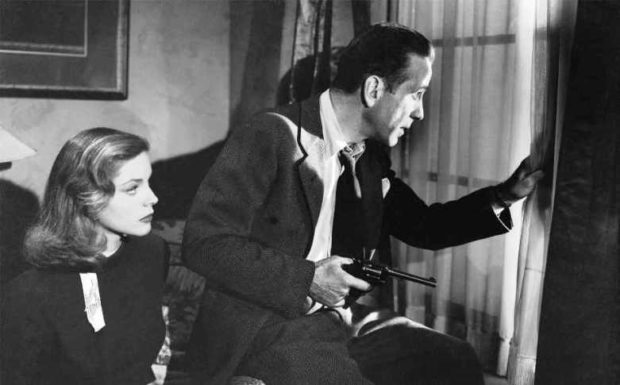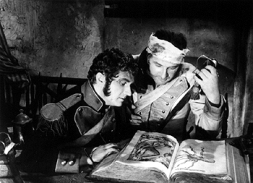 Howard Hawks’ classic 1946 crime film stars Humphrey Bogart as hard-boiled L.A. detective Philip Marlowe, trying to solve one of the most complicated mysteries ever made.
Howard Hawks’ classic 1946 crime film stars Humphrey Bogart as hard-boiled L.A. detective Philip Marlowe, trying to solve one of the most complicated mysteries ever made.
It’s hard for me to believe that I’ve been doing this show for 17 years, and yet I haven’t talked about one of my favorite movies, The Big Sleep, until now. I’m referring to the 1946 Howard Hawks film starring Humphrey Bogart and Lauren Bacall. The Big Sleep was originally a crime novel by Raymond Chandler, featuring Chandler’s recurring hard-boiled detective character Philip Marlowe. Bogart plays Marlowe. He also played Dashiell Hammett’s detective Sam Spade five years earlier in John Huston’s The Maltese Falcon, making him the only actor to have played both these iconic characters. Actually he was always playing the most entertaining character of all, Humphrey Bogart. But I digress.
Marlowe gets hired by an old man, General Sternwood, who has received threatening letters concerning the payment of his youngest daughter’s gambling debts. The assignment is to find out what kind of trouble the daughter, named Carmen, is actually in, and help her out of it, if possible. What he soon finds is the blackmailer’s dead body, in a gangster’s deserted house, with a drugged Carmen there as, apparently, the fall girl. She is a wild seductive young socialite, played with sleazy zest by the 20-year-old Martha Vickers.
Back at the Sternwood’s, Marlowe encounters Carmen’s older sister, Vivian, played by Lauren Bacall, who doesn’t seem very happy to meet him, and as it turns out has her own secrets to protect. Marlowe’s relationship with Vivian becomes both romantic and dangerous.
To try to follow the plot any further would involve a dizzying array of killers, gamblers, kidnappers, cops, and blackmailers. Bogart strides through this incredibly complicated story with complete disregard for niceties and a humorous quip for every occasion. The film is often quite funny. Ultimately, though, the title The Big Sleep refers to death, and Marlowe’s smart aleck tough guy is surrounded by darkness and menace at all times. The constant sense of danger heightens the movie’s excitement, while the main character’s brass-knuckled self assurance puts a smile on our face. A lot of people call it film noir, and I suppose it is, but it’s directed by Howard Hawks, and that means, before anything else, that it’s fun.
Many critics and viewers complain that the plot is impossible to understand. Supposedly even the screenwriters—one of whom was William Faulkner—had some trouble figuring out exactly who killed whom. But the truth is, the picture was first shot in 1945, and that version, which some DVD or Blu Ray editions include as an extra, was understandable, although admittedly complicated. But the producers didn’t think that it was enough. Bogie and Bacall were an item at this point, and they wanted the romance between those two highlighted. So Hawks cut out a few scenes, and parts of scenes here and there, inserted new scenes of the two main characters doing witty repartee and double entendre, and redid the ending emphasizing Bacall more, and it all worked. The chemistry between Bogie and Bacall really improved the movie’s snap. The only trouble is, the stuff that was cut out explained quite a few things in the plot that now seem sketchy in the final version. But… none of this ever harmed my enjoyment of the film, which is really about the energy and dark intrigue, plus brilliant dialogue and of course Bogart’s dynamic performance. I’ve watched The Big Sleep again and again for years, and I’m not tired of it yet.

An ambitious young man from a lower caste seeks to prosper by attaching himself to a corrupt businessman and his family, in this thriller...

The Saragossa Manuscript, a 1965 film from Poland directed by Wojciech Has, became something of a cult favorite among younger American moviegoers at the...

A documentary portrait of Ruth Bader Ginsburg reveals the life story of the Supreme Court Justice and her key role in advancing women’s rights...